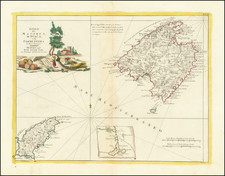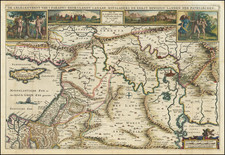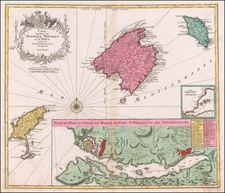Plan of the Siege of Fort St. Philip Signed By A Future US Consul
Finely executed manuscript map showing the Second Siege of Minorca.
The map is oriented with southwest at the top, showing the bombardment of the British held Fort St. Philip from three sides, by an allied French and Spanish force, which held the fort under Siege for a number of months before the British Surrender in February 1782. Arrayed to the west, east and north of the Fort, over a dozen fortified assault positions are shown, with numbers of Cannon and Mortars given. To the north several chain barriers are shown, blocking entrance to the north of the bay, where 3 ships can be seen around an island noted as Quarantine.
"The map is signed John Martin Baker Junior Fecit 1782." The map is entirely in French, but the scale of miles is done in English Miles. The numbered and lettered key locates over 30 points of interest during the siege, along with numerous additional details within the image.
Along the perimeter, the encampments of the French Lionnois, Bretania, Bouillon and the Royal Suedois (Royal Swedes troops are shown at the bottom, Across the top, a group of Spanish encampments are shown, including Catalognia, Betcher, Princesa, Ultonico, Savoye, Murcia, Burgos and America. In the center, the encampments of the Foot Dragoons, Mounted Dragoons and Artillery are shown. At the top left, an encampment of Grenadiers is shown.
The work is exceptionally well executed and must have been prepared to illustrate the status of the siege of the fort shortly before the British capitulation.
Siege of Minorca 1782
The Siege of Minorca resulted in the Franco-Spanish conquest of Minorca from its British defenders in February 1782. The Siege followed the Siege of Fort St. Philip, which lasted over five months, was an important step in the achievement of Spain's aims in its alliance with France against Britain during the American War of Independence.
The ultimate result was the ceding of the island to Spain in the Treaty of Paris in 1783.
John Martin Baker
John Martin Baker would appear to have been born in Minorca and ultimately served for over 30 years as US Consul to various places in the Mediterranean and later Rio De Janeiro. He as the author of Commerce of the United States and the Mediterranean Sea-Ports Including The Adriatic and Morea . . . From the Manuscript of the Late John Martin Baker (published posthumously by his son, Louis Baker).
John Martin Baker was likely related to Admiral John Baker, who was Minorca's Governor until 1716. Records show that a John Martin Baker, born in Minorca, was the son of Charles Baker, one of the most important British merchants on the island in the period immediately prior to the Second Siege. The same reference notes an unnamed grandson, who may also have been named John Martin Baker. John Martin Baker petitioned the British Secretary of State in 1782 for compensation for his loss of a brewery and merchandise following the siege. It seems that Baker thereafter move to America and obtained citizenship.
Following the British defeat in Minorca, there seems little information on John Martin Baker until his name begins to appear in correspondence between Thomas Jefferson and John Madison in 1802. Founders Online provides the following overview in its footnote to a letter from Jefferson to Madison dated August 20, 1802:
. . . endorsed by TJ as received from the State Department at Orange on 21 Aug. and “John Martin Baker to be consul [. . .]” (torn) but recorded in SJL as received 20 Aug. Enclosures (see Madison, Papers, Sec. of State Ser., 3:447–8, 451): (1) Frederick Weissenfels to Edward Livingston, New York, 28 July 1802, asking Livingston to recommend John Martin Baker, who is Weissenfels’s son-in-law, to be vice consul at Bordeaux or Gibraltar; Baker is “master” of the English, Spanish, French, and Italian languages, has “a General Knowledge” of commercial matters, and is of good character, which allows Weissenfels to “Vouch for his abilitys, Honor and Fidelity” (RC in DLC); see Enclosure No. 3. (2) Certificate, New York, 30 July, attesting to Baker’s knowledge of languages, good character, and commercial ability (RC in same; in Baker’s hand, signed by Weissenfels, William Tredwell, and John Casenave); see Enclosure No. 4. (3) Livingston to Madison, New York, 31 July 1802, enclosing Weissenfels’s letter (Enclosure No. 1); Livingston knew Baker at Philadelphia about four years ago, when Baker worked as clerk for a gentleman who had “very extensive concerns” . . .
* * *
his expectations: Baker wrote to Madison from New York on 28 Nov. 1802 to say that the islands of Majorca and Ibiza should be included in the consulate for Minorca and that he and his family were “ready to embark” (RC in DNA: RG 59, LAR; endorsed by TJ as a letter from Baker to Madison and “to be Consul of Majorca Minorca Yvica”). Baker again wrote to the secretary of state from New York on 4 Jan. 1803, indicating that a ship would be leaving for the Mediterranean in three weeks and that Baker hoped to take advantage of that opportunity, “being particularly pressed through Mrs. Baker’s present situation” (RC in same; endorsed by TJ as from Baker to Madison and “to be Consul at Minorca”). TJ nominated Baker to be consul for Minorca, Majorca, and Ibiza early in February 1803 and signed a commission for him on 1 Mch. (commission in Lb in DNA: RG 59, PTCC; TJ to the Senate, 2 Feb. 1803).
Baker would remain as consul in the Balearic Islands for a number of years, writing periodically to Jefferson from Mahon in Minorca. He is still listed as consul under the Jackson administration in 1832. At some point, he was named Consul to Spain in Tarragona. By 1834, he was serving as Consul in Rio de Janeiro.










![Spain and Portugal, with Their General Divisions . . . [Balaeric Islands]](https://storage.googleapis.com/raremaps/img/small/65193.jpg)

![Valetta, the Capital of the Island of Malta [with] Balearic Islands [and] Corsica and Sardinia](https://storage.googleapis.com/raremaps/img/small/87300.jpg)
![[Minorca] A Correct Map of the Island of Minorca By John Armstrong Esqr. Engineer in Ordinary to his Majesty with many Additions and Improvements From the late surveys. . . . 1794](https://storage.googleapis.com/raremaps/img/small/71522.jpg)
